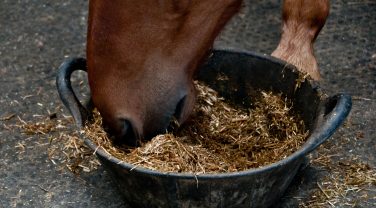Carbohydrates in your horse’s diet
‘Carbs’ usually feature in weight-loss diets, whether it’s no carbs, low carbs or no carbs after 5pm! As there are different types of carbohydrates, which are often given different names, it’s no wonder that a lot of confusion surrounds them both in human and equine nutrition.
Back to basics
There are three distinct groups of carbohydrates:
- Simple sugars, e.g. glucose, fructose.
- Storage sugars, e.g. starch, fructan.
- Structural polysaccharides or ‘fibre’, e.g. cellulose.
Simple sugars
Simple sugars are also referred to as water-soluble carbohydrates because they are soluble in water or gut fluids. The most common sugar in plants is sucrose, which is a double sugar (disaccharide) consisting of glucose and fructose. Grass is by far the greatest source of sugar in most leisure horse’s diets and this is why access to grass must be restricted to individuals prone to laminitis. A lot of the sugar is lost from grass when it is made into hay, but soaking hay prior to feeding can remove even more. Research suggests soaking hay for 16 hours at 16°C is most effective at removing sugar.
Storage sugars
The plant makes sugar to use as its own energy source for growth. When it has more sugar than it needs, it stores the surplus. Grasses in temperate regions store sugar as fructan in the leaves and stems, and as starch in seeds. If paddocks are grazed regularly, the grass rarely gets the opportunity to go to seed, so starch levels in grass are usually relatively low.
Fructan tends to accumulate in grass when the grass plant isn’t growing. Because light is required for sugar production (photosynthesis) but a temperature above 5°C is needed for growth, cold bright mornings can result in high levels of fructan accumulating.
Cereal grains such as barley and wheat are the seed of the cereal plant, so contain very high levels of starch. Just as you and I wouldn’t eat raw potatoes or pasta because they wouldn’t be very digestible, cereals fed to the horse can be cooked to improve their digestibility and reduce the risk of digestive upsets.
Structural carbohydrates
The final group of carbohydrates is fibre, which can also be referred to as structural carbohydrates. Cellulose is the most abundant carbohydrate in the world, making up between 20% and 40% of the dry matter of plants. Cellulose, like starch, is made up of glucose molecules, but it is the bonds linking the glucose together that differ, creating two very different carbohydrates.
Cellulose is joined in a way that means enzymes produced by mammals, including both humans and horses, are unable to break down the bonds. Herbivores rely on the population of bacteria present in their digestive systems to break down the bonds and release the energy from the fibre. The lack of fibre digesting bacteria in our digestive systems means that, in contrast to the horse, we can’t use fibre as an energy source.
Feeding carbohydrates to horses
Fibre should form the basis to all horses’ rations. Because it is a complex structure, it takes the bacteria a long time to break it down, so fibre provides slow-release energy. Relative to this, starch provides quick-release energy for horses, but for humans it is the slowest source of energy because we can’t access energy from fibre. This is why porridge oats for breakfast should keep you feeling full for longer and yet oats can act like rocket fuel for some horses!
If you would like further information, please do not hesitate to telephone the Dengie Feedline on 01621 841188.



